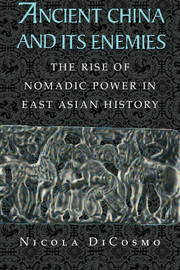Book contents
- Frontmatter
- Contents
- Acknowledgments
- Introduction
- Part I
- Part II
- Part III
- Part IV
- 7 In Search of Grass and Water: Ethnography and History of the North in the Historian's Records
- 8 Taming the North: The Rationalization of the Nomads in Ssu-ma Ch'ien's Historical Thought
- Conclusion
- Glossary
- Select Bibliography
- Index
7 - In Search of Grass and Water: Ethnography and History of the North in the Historian's Records
Published online by Cambridge University Press: 25 August 2009
- Frontmatter
- Contents
- Acknowledgments
- Introduction
- Part I
- Part II
- Part III
- Part IV
- 7 In Search of Grass and Water: Ethnography and History of the North in the Historian's Records
- 8 Taming the North: The Rationalization of the Nomads in Ssu-ma Ch'ien's Historical Thought
- Conclusion
- Glossary
- Select Bibliography
- Index
Summary
Introduction
This section is dedicated to an analysis of how the history of the Hsiung-nu came to be written by Ssu-ma Ch'ien. As discussed in Part III, the Hsiung-nu had become a phenomenon whose effects on Han life – military, economic, and political – could not be ignored. However, by itself that consideration is surely insufficient to establish how the historian constructed his narrative of the northern nomads, and how he was able to incorporate this narrative within the general scope of his opus magnum.
The issue is important, at the very least, in two respects: there is no obvious precedent that Ssu-ma Ch'ien could have used for inspiration, and the pattern established by Ssu-ma's Hsiung-nu narrative became the model for representations of northern peoples and Inner Asian states in the subsequent Chinese historical literature. As we will see, two orientations can be detected in accounts of the Hsiung-nu, and of Inner Asia in general: one empirical, descriptive, and data oriented, the other normative, ideological, and influenced by currents of contemporary thought. Both orientations were consistent not only with the declared goals of the historian but also with the general thinking of an age, the early Han, inclined to the construction of universal cosmological paradigms and unified historical patterns. Hence the account of the Hsiung-nu appears as a combination of various contemporary concerns and intellectual pursuits.
I have therefore divided the materials on the Hsiung-nu into two different sets of data.
- Type
- Chapter
- Information
- Ancient China and its EnemiesThe Rise of Nomadic Power in East Asian History, pp. 255 - 293Publisher: Cambridge University PressPrint publication year: 2002



